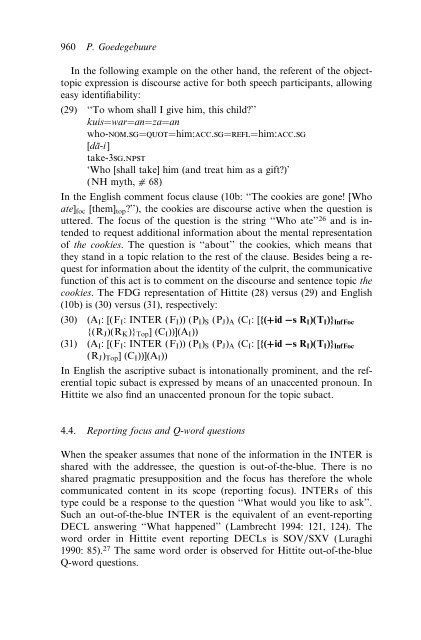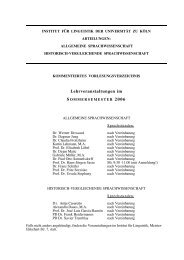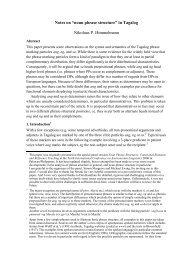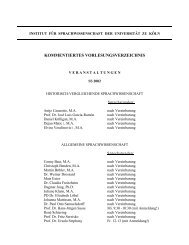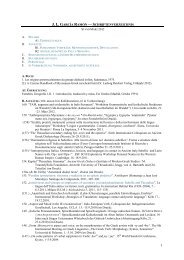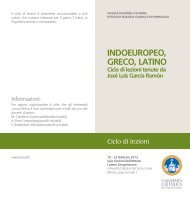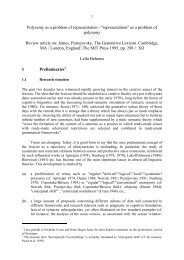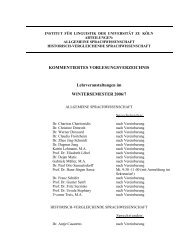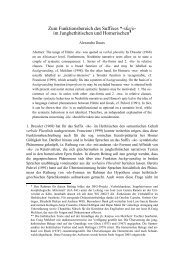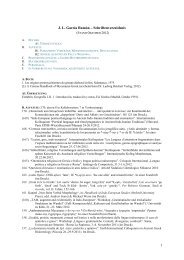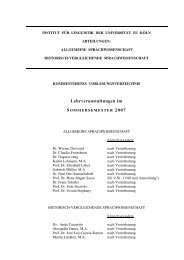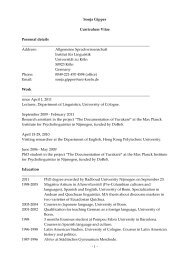Topics in Anatolian Historical Grammar Prof. Dr. H. Craig Melchert
Topics in Anatolian Historical Grammar Prof. Dr. H. Craig Melchert
Topics in Anatolian Historical Grammar Prof. Dr. H. Craig Melchert
You also want an ePaper? Increase the reach of your titles
YUMPU automatically turns print PDFs into web optimized ePapers that Google loves.
960 P. Goedegebuure<br />
In the follow<strong>in</strong>g example on the other hand, the referent of the objecttopic<br />
expression is discourse active for both speech participants, allow<strong>in</strong>g<br />
easy identifiability:<br />
(29) ‘‘To whom shall I give him, this child?’’<br />
kuis¼war¼an¼za¼an<br />
who-nom.sg¼quot¼him:acc.sg¼refl¼him:acc.sg<br />
[dā-i ]<br />
take-3sg.npst<br />
‘Who [shall take] him (and treat him as a gift?)’<br />
(NH myth, a 68)<br />
In the English comment focus clause (10b: ‘‘The cookies are gone! [Who<br />
ate] foc [them] top ?’’), the cookies are discourse active when the question is<br />
uttered. The focus of the question is the str<strong>in</strong>g ‘‘Who ate’’ 26 and is <strong>in</strong>tended<br />
to request additional <strong>in</strong>formation about the mental representation<br />
of the cookies. The question is ‘‘about’’ the cookies, which means that<br />
they stand <strong>in</strong> a topic relation to the rest of the clause. Besides be<strong>in</strong>g a request<br />
for <strong>in</strong>formation about the identity of the culprit, the communicative<br />
function of this act is to comment on the discourse and sentence topic the<br />
cookies. The FDG representation of Hittite (28) versus (29) and English<br />
(10b) is (30) versus (31), respectively:<br />
(30) (A I :[(F I : INTER (F I )) (P I ) S (P J ) A (C I :[{(Bid Cs R I )(T I )} InfFoc<br />
{(R J )(R K )} Top ](C I ))](A I ))<br />
(31) (A I :[(F I : INTER (F I )) (P I ) S (P J ) A (C I :[{(Bid Cs R I )(T I )} InfFoc<br />
(R J ) Top ](C I ))](A I ))<br />
In English the ascriptive subact is <strong>in</strong>tonationally prom<strong>in</strong>ent, and the referential<br />
topic subact is expressed by means of an unaccented pronoun. In<br />
Hittite we also f<strong>in</strong>d an unaccented pronoun for the topic subact.<br />
4.4. Report<strong>in</strong>g focus and Q-word questions<br />
When the speaker assumes that none of the <strong>in</strong>formation <strong>in</strong> the INTER is<br />
shared with the addressee, the question is out-of-the-blue. There is no<br />
shared pragmatic presupposition and the focus has therefore the whole<br />
communicated content <strong>in</strong> its scope (report<strong>in</strong>g focus). INTERs of this<br />
type could be a response to the question ‘‘What would you like to ask’’.<br />
Such an out-of-the-blue INTER is the equivalent of an event-report<strong>in</strong>g<br />
DECL answer<strong>in</strong>g ‘‘What happened’’ (Lambrecht 1994: 121, 124). The<br />
word order <strong>in</strong> Hittite event report<strong>in</strong>g DECLs is SOV/SXV (Luraghi<br />
1990: 85). 27 The same word order is observed for Hittite out-of-the-blue<br />
Q-word questions.


